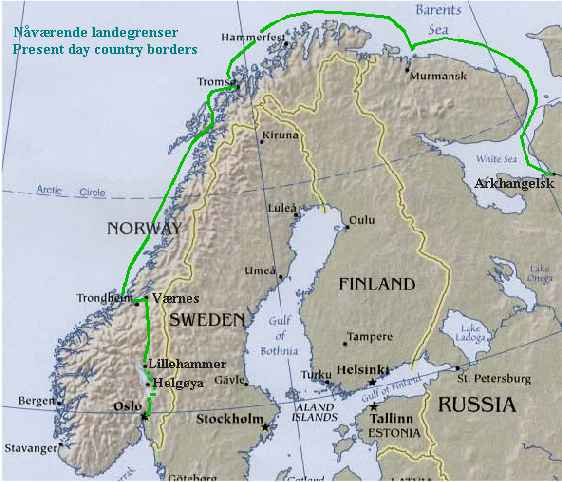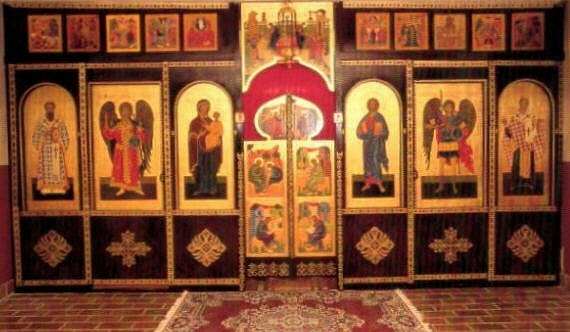
In the beginning of the last century there were no orthodox congregations in Norway. The only orthodox believers were a small group of Skolte-sámi in Finnmark region in northern Norway. Russia is Norway's closest Orthodox country and the Russians brought the Orthodox Church to this country. In Oslo - at the time Kristiania, there were a Russian consulate. (During the 19th century Norway were in union with Sweden and the embassy were located in Stockholm). However, the small Russian community here were not able to establish an independent congregation and had to call on the Russian priest in Stockholm for baptism, matrimonials, funerals and other services. The leader of this community was consul Christofor Kristi.
The change occurred after the Russian revolution and the following civil had taken place. These events drove millions of people from their homeland to other parts of Europe. The first official Orthodox liturgical service in Kristiania was the partastos in remembrance of the murdered Russian Tsar family. The service was taking place in the Russian consulate and led by the priest Rumjantsev in the presence of His Royal Highness King Haakon, the diplomacy and the Russian colony.
The "white" side of the civil war were defeated and the northern army, led by general Miller, had to evacuate. In 1920 about 1000 people embarked the icebreaker "Kuzma Minin" in Arkhangelsk. The ship had four times as many passengers than stated in the registration documents. On May the 6th they reach Tromsø in northern Norway where the refuges were registered. They were transported further south - to Stjørdalen in mid Norway and accommodated in the barracks of army camps at Værnes and Øyangmoen. Among the refugees were the priest Nikolai Podosenov. He organised then first celebration of Pascha on Norwegian soil. Later they were relocated to Lillehammer. Some found their home there - others, about half the group, left Norway and settled in other European countries. The remaining part were steadily approaching Oslo, the final destination.

This group of Russian refuges became the core of the congregation that were established some years later. On May 11th 1921, during a meeting in the Russian consulate, Rumjantsev, the priest from Stockholm, proposed to investigate the possibilities of establishing a branch of the Stockholm congregation in Oslo. In a new meeting on May 16th, the decision to form a branch were taken. However, this initiative proved to be difficult to put to reality. The reason might be found in differences between the well established Russian colony around the consulate and the relatively poor newcomers who were organised in "the Russian Emigration Society". In the years between 1921 and 1929 ecclesiastical activity took place only sporadically on initiative from the one or the other group. When taking place, liturgy were celebrated in the consulate or in a local school.
A group of initiators of a Russian Orthodox congregation in Oslo were established in 1929. The members were P. Jankov in addition to E. Gorjunov and P. Rimski-Korsakoff, the last two of military background. This initiative involved Fr. Aleksander Rouberts from the Stockholm congregation who demanded that the two fractions had to come to an agreement before a new congregation could be established. This again, resulted in a "general assembly" for all Orthodox who were living in Oslo. On April 8th 1931 the congregation was formally established with the priest Peter Rumjantsev from Stockholm as principal.
The most important task for the new congregation was to organize a few liturgical services a year. From 1931- from the formal establishment and onward - the ambulating situation ended. The congregation were offered the permission to use Capella Johannea in the "Church of the priests" (The Majorstuen Church). Liturgy were celebrated 3 - 4 times a year, during Christmas, Pascha and once in the summer season. In addition, baptism, funerals and matrimonial services were taking place. The members collected icons, textiles, books and other necessary items for liturgy and other purposes. When liturgy were celebrated, the altar, iconostasis, candle-stands were put up and Capella Johannea was transformed to a genuine Orthodox Church.
In 1933, the congregation received a considerable donation from the Finnish Orthodox Church, An entire iconostasis (seven large icons), epitafion and other textiles from the 18th and 19th century from the old Valamo monastery. On special occasions the main Church were used - for example when the Rumanian prince Sturdza and one Miss Kvaal were married or when a parastos for Queen Maria of Greece were taking place in 1938 in the presence of the King of Norway. - In these establishing years the congregation were supported by the Rumanian legation in Oslo. The leader of the congregation was Georg von Mekk and the elder of the Church, Eugenij Gorjunov.
In 1935 the priest Rumjantsev diseased and Fr. Aleksander Rouberts took over as new principal, thus continuing to live in Stockholm. In 1936 the congregation became independent from Stockholm. The most important concern at the time was to find a permanent location. The outcome of his efforts granted the congregation permission to take over the crypt under Capella Johannea. The Church room were planned, engineered and constructed by the architect Kristen Sand and the engineer Ellefsen. The building activity were taking place in the autumn of 1939 and on January 4th 1940 the Church were inaugurated according to the old rituals in the presence of the congregation and representatives of the Norwegian Church. For the record, the priest Prytz from the "Church of priests" must be mentioned especially. He was kindly assisting and helping the congregation in the establishing of the Church.
During WW II and the German occupation of Norway, the congregation met severe problems. The priest, who were located in neutral Sweden, was not granted visiting visas. In this situation, some of the members carried out a motion regarding the employment of a stationary priest in Oslo. A group of initiators were established. Via P. Rimski-Korsakof they contacted the then nazi controlled state department of the Norwegian Church. However, this was not accepted by the legally elected council of the Church. All members withdraw and the mentioned "initiative group" took over. During the last years of war and occupation there were some activity in the Church. The group had employed a priest from the German occupied Russia, Fr. Eugenij Vasiljevitsh. It must have been a big event when the pro-German general Vlassov visited Oslo together with his accompanies. Liturgy was celebrated appealing to the local colony in the hope of winning support in the fight against the Soviet power.
After the war, the legal council of the Church once again took over. Alexander Roubets wished to withdraw due to health reasons. In 1947 the young priest Illja Adamoff came from Estonia via Sweden with wife and two daughters. After five years he emigrated to America.
The Russian colony in Norway was never large and as the years passed by it diminished considerably. Some new groups came after the war, but could not replace the elderly that fell from. Many of the newly arrived were already old and worn out after having traveled through Siberia, lived for years in Hong Kong, Shanghai or Istanbul - before they came to Norway as low-priority refuges. The congregation soon had many non-Russian members. In 1952 the congregation got a new priest, Fr. Therapon Hümmerich, who was neither Russian nor orthodox by birth. Some of the Russian members did not approve of this development, and blamed the new priest for further weakening of the Russian character of the Church.
In cooperation with the Norwegian council for Refugees, Fr. Therapon contributed actively in establishing an institutional home for the Russians who came from the Far East. The newly arrived Russian senior citizen took an active part themselves and in 1956 an orthodox chapel were built. Fr. Therapon traveled to and from several times a year to officiate liturgy and other services. "Granlien", located on the beautiful island Helgøya in lake Mjøsa north of Oslo, were closed in 1983 and the chapel taken apart. We still have fond memories of the era and since then the congregation are officiating parastos every summer for those who are resting there - often in close cooperation with the local congregation from the Norwegian Church.
 In
the end of the 70'ies it may have looked like the congregation would come to
an end. The health of Fr. Therapon was not good and no new priest came to replace
him. The Church were shut down for some years and the activity were almost non-existent.
However, common efforts and the with the help of God it has been possible to
re-establish a vital and prosperous congregation.
In
the end of the 70'ies it may have looked like the congregation would come to
an end. The health of Fr. Therapon was not good and no new priest came to replace
him. The Church were shut down for some years and the activity were almost non-existent.
However, common efforts and the with the help of God it has been possible to
re-establish a vital and prosperous congregation.
The pan-orthodox character of the Church became more evident towards the end of the 50'ies and beginning of the 60'ies as more non-Russians became members. After some years, there was even established an offspring in form of a Greek congregation. Hl. Nikolai Church remains a non-national or national neutral congregation with the basis in the Russian tradition. The congregation is aware of its traditions and identity. However, we strive to bring this in a form and in a language the new generations can understand and look upon as their own.
In 1986 Hl. Nikolai Church was totally destroyed by fire. Thanks to soldiery help from other congregations, single persons and Norwegian authorities the repair works was soon under way. Most of the old interior was destroyed or severely damaged. A new iconostasis and new icons were created by our icon-painter, Ove Grant Svele. New liturgical items were provided from Greece and Poland.
The golden icons are shining on the iconostasis. Christ, The Mother of God with the infant are located in their traditional places to the right and left of the Kings gate in the middle. Further to the right, the archangel Michael and St. Nikolai. To the left, the archangel Gabriel and St. Sava. The iconostasis is 2,6 meter high and 5,35 meter wide.